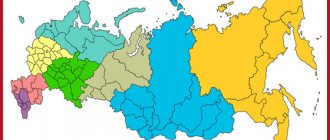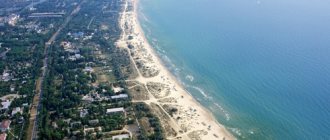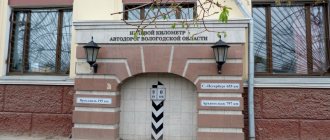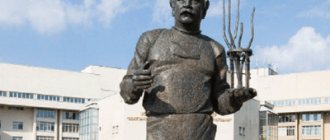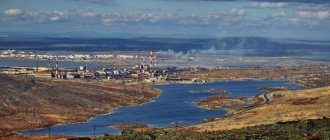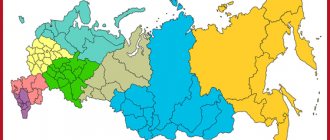How did the region appear?
Trans-Baikal Territory can be called a relatively young region. The first people appeared here no more than 35 thousand years ago. The first settlements were discovered near the current capital.
The formation of the Trans-Baikal Territory began with the unification of the Buryat Autonomous Okrug and the Chita Region in 2007. The heads of local government sent an official letter to the President of the Russian Federation. The official date of creation of the region is March 11, 2007. On this day a referendum was held. The people had to express their opinion on the unification of several administrative units into the Trans-Baikal Territory. The capital of the region was chosen a little later.
Today Transbaikalia is a fairly large region inhabited by people of various nationalities. According to the latest population census, the total population of the Trans-Baikal Territory is 1,087,479 people. The most populated is the central part of the region. But in the northern part the population is quite weak.
Story
1783-1805. Nerchinsk region
On March 6, 1783, on the basis of a Nominal Decree, the Irkutsk governorship was formed as part of four regions, including the Nerchinsk region
(center - the city of Nerchinsk), which was divided into 4 districts:
- Barguzinsky district (center - the city of Barguzinsk)
- Doroninsky district (center - the city of Doroninsk)
- Nerchinsky district (center - the city of Nerchinsk)
- Sretensky district (center - the city of Sretensk)
Counties of the Nerchinsk region of the Irkutsk governorship, 1792 On
December 12, 1796, the Nerchinsk region became part of the newly formed Irkutsk province.
In 1798, Doroninsky and Sretensky districts were abolished, and their territory became part of the Nerchinsky district.
On April 22, 1805, according to the Personal Decree, the Nerchinsk region was liquidated, the Nerchinsk district became part of the Irkutsk province (see below ATD of the Irkutsk region)
.
1851-1919. Transbaikal region
On July 11, 1851, by separating from the Irkutsk province the Verkhneudinsky and Nerchinsky districts and the Kyakhtinsky city administration), the Transbaikal region was formed, which included most of the current Transbaikal region.
On February 9, 1863, by a personal decree, the Kyakhta city government was abolished, its territory became part of the Trans-Baikal region.
In 1870, three new districts were formed: Barguzinsky, Selenginsky and Chita, in 1872 - three more: Troitskosavsky, Akshinsky and Nerchinsko-Zavodsky. In 1901, the districts were transformed into counties.
Initially, the region was part of the East Siberian General Government. On June 16, 1884, it was transferred to the Amur Governorate General. March 17, 1906 - included in the Irkutsk General Government, where it remained until March 1917.
After the adoption of the Statute on temporary management bodies in October 1917 at the All-Buryat Congress in the city of Verkhneudinsk, the territorial, economic and administrative demarcation of the Buryat and Russian populations began. The Buryat population living in the Trans-Baikal region is united into somons, khoshuns and aimaks. In the Trans-Baikal region, aimaks were formed: Aginsky, Barguzinsky (along with Barguzinsky district), Khorinsky and Selenginsky. In connection with the organization of the latter, the Selenginsky district was abolished, the Russian population of which joined the Troitskosavsky and Verkhneudinsky districts. The following year, Verkhneudinsky district was divided into two districts: Verkhneudinsky and Petrovsko-Zabaikalsky.
1920-1926. Transbaikal region, province
On April 6, 1920, the Far Eastern Republic was proclaimed, which included, among other things, the Transbaikal region.
On November 22, 1920, by decree of the government of the Far Eastern Republic, the Pribaikalsk region
, consisting of 3 counties: Barguzinsky, Verkhneudinsky and Troitskosavsky.
On November 10, 1922, the remaining part of the Transbaikal region was transformed into the Transbaikal province (center - the city of Chita), which was divided into six counties:
- Akshinsky
- Alexandrovo-Zavodsky
- Nerchinsky
- Nerchinsko-Zavodsky
- Sretensky
- Chitinsky
On November 15, 1922, the Presidium of the All-Russian Central Executive Committee adopted a resolution “On the unification of the RSFSR and the Far Eastern Republic as the Far Eastern Region
"with a center in Chita (since December 1923 - in Khabarovsk). It included regions of the Far Eastern Republic, renamed into provinces: Amur, Transbaikal, Amur, Pribaikal, Primorsk (with the northern part of Sakhalin Island) and Kamchatka region of the RSFSR. The Far Eastern Region was also administratively subordinate to the right-of-way of the Chinese Eastern Railway.
By January 1, 1926, the administrative-territorial structure of the Transbaikal province was as follows:
1926-1930. Sretensky and Chita districts of the DCK
On January 4, 1926, by resolution of the Presidium of the All-Russian Central Executive Committee, the Far Eastern Region was transformed into the Far Eastern Territory with its center in Khabarovsk. The same decree established a district and district system for dividing the region. The DCK included 9 districts, divided into 76 districts, including:
- Sretensky - within the Sretensky district (with the exception of part of the Pokrovskaya volost), Nerchinsky district (with the exception of Mogochinskaya, Razmakhinskaya, part of the Shilkinskaya and part of the Novo-Troitskaya volosts), and part of the Aleksandrovo-Zavodskaya volost of the Borzinsky district of the Transbaikal province
- Chitinsky - within the Chita district, Borzinsky district (with the exception of the Aleksandrovo-Zavodskaya volost), Razmakhinsky volost, part of the Shilkinsky and part of the Novo-Troitskaya volosts of the Nerchinsky district of the Transbaikal province
In 1926, the village of Petrovsky Zavod received city status and was renamed Petrovsk-Zabaikalsky; the district retained its name - Petrovsko-Zavodsky until 1963.
On July 1, 1927, the Khoatsai and Khiloko-Buryat khoshuns were transformed into national districts.
1930-1936. Districts of the East Siberian Territory
On July 30, 1930, the Chita and Sretensky districts of the Far Eastern Territory were transferred to the newly formed East Siberian Territory. At the same time, the okrugs were abolished, their districts became directly subordinate to the East Siberian Territory, and the Zeya Okrug became subordinate to the Far Eastern Territory.
On December 10, 1930, from the southern tip of the Bodaibo region (the so-called Kalarsky corner), the Vitimo-Karengsky native region of the East Siberian Territory and the territory in the area of the Nyukzha and Olekma rivers (the so-called Tupikovsky native region) of the Yakut Autonomous Soviet Socialist Republic, the Vitimo-Olyokma National (Evenkisky) ) district
(center - Ust-Muya; temporarily) as part of the East Siberian Territory. The district consisted of 4 districts:
- Vitimo-Olyokminsky (center - Tolochi trading post on the Karenga River)
- Kalarsky (center - workers’ settlement named after the 11th anniversary of the October Revolution on the Katymyakhta River; temporary)
- Machinsky (center - Himolho)
- Tupikovsky (center - Dead End)
In 1931, the Khoatsai and Khiloko-Buryat national regions were united into the Khiloko-Khoatsai region with its center in Mogzon.
In 1932, the Khiloksky district was abolished, the territory of which became part of the Khiloko-Khoatsaisky, Petrovsk-Zabaikalsky and Krasnoyarsk districts.
In 1933, the village of Krasny Yar, the center of the Krasnoyarsk region, was renamed Krasny Chikoy, and the district was renamed Krasnochikoysky.
In 1934, the Khilok-Khoatsai district was renamed the Ulan-Khilok territorial district.
On February 11, 1935, the Zhidkinsky district (center - the village of Zhidka) was liquidated. Part of its territory was included in the newly formed Baleysky district, part - in the newly formed Shakhtama district (center - the village of Shelopugino). At the same time, from the liquidated Ulan-Khiloksky, part of the territory of the Petrovsk-Zabaikalsky and Krasnochikoysky districts, the Khiloksky district was re-created (the center is the village of Khilok).
In 1935, the Olinsky district (center - the village of Olinsk), the territory of which became part of the Nerchinsky district, was also abolished; Maletinsky district, the territory of which became part of the Petrovsko-Zabaikalsky district.
On December 5, 1936, the East Siberian Territory was divided into the Buryat-Mongol Autonomous Soviet Socialist Republic and the East Siberian Region
(center - the city of Irkutsk) consisting of 45 districts.
1937-2008. Chita region and ABAO
1937-1950
The Chita region as part of the RSFSR with its center in Chita was formed on September 26, 1937 as a result of the division of the East Siberian region. The newly formed Chita region included, among other things, 6 districts of the liquidated Zeya region:
- Dzheltulaksky
- Zeysky
- Zeysko-Uchursky
- Mogochinsky
- Rukhlovsky
- Tygdinsky
And also two aimags of the Buryat-Mongolian Autonomous Soviet Socialist Republic, transformed into the Aginsky Buryat-Mongolian National District
(ABMNO) Chita region:
- Aginsky
- Ulan-Ononsky
On September 2, 1938, the Vitimo-Olyokminsky national district was liquidated, the territory of which became part of the Chita region. The following districts were created:
- Kalarsky
- Nyukzhinsky
- Tungiro-Olyokminsky (September 21)
- Tungochensky (September 21; center - the village of Tungochen)
On December 16, 1938, the city of Rukhlovo was renamed the city of Skovorodino, and the Rukhlovsky district was renamed Skovorodinsky.
By April 1, 1940, the ATD of the Chita region looked like this:
February 5, 1941 as a result of the disaggregation of Olovyanninsky ( Bain-Tsagansky, Buylesansky, Ikaralsky, Kobukhayvsky, Kuranzhinsky, Novo-Durulguysky, Staro-Durulguysky, Staro-Chandantsky, Tut-Khaltuysky, Ust-Liskansky and Tsasucheysky village councils
) and Borzinsky (Kulusutaisky and Solovyovsky village councils) districts, the Onon district was formed (the center is the village of Nizhny Tsasuchey), which also included part of the Ulan-Onon aimak. The remaining part of the Ulan-Onon aimak was renamed the Duldurga district of ABMNO (center - the village of Duldurga). In the same year, the Aginsky and Mogoituy districts of ABMNO were formed in the Aginsky district.
On December 8, 1942, Burinsky, Verkhne-Kalgukansky, Donovsky, Kalgansky, Nizhne-Kalgukansky, Chingilsky, Chingiltuysky and Chuprovsky village councils
Byrkinsky district and
Bolshe-Zerentuysky, Gorno-Zerentuysky, Zolotonoshinsky, Ivanovsky, Kadainsky, Kozlovsky, Kutomarsky, Mikhailovsky, Potaskuisky, Sredne-Borzinsky, Chashchino-Ildikansky and Yavlensky village councils of the
Nerchinsko-Zavodsky district.
On June 19, 1948, by decree of the Presidium of the Supreme Soviet of the RSFSR, the Aginsky, Mogoituysky and Duldurginsky districts as part of the ABMNO were liquidated. On August 2 of the same year, Dzheltulak, Zeya, Zeysko-Uchursky, Nyukzhinsky, Skovorodinsky and Tygdinsky districts of the Chita region were included in the Amur region.
1951-1962
On August 25, 1951, the Aginsky, Mogoituysky and Duldurginsky districts of the Aginsky Buryat-Mongolian National District were restored.
On September 16, 1958, the Aginsky Buryat-Mongolian NO was renamed the Aginsky Buryat National District.
In 1959, the Ust-Karsky district (center - the village of Ust-Karsk) was liquidated, the territory of which became part of the Sretensky district.
On August 24, 1961, the Shakhtaminsky district was renamed the Shelopuginsky district.
On March 30, 1962, by Decree of the Presidium of the Supreme Soviet of the RSFSR, the Byrkinsky district was renamed Priargunsky with the transfer of the district center from the village of Byrka to Priargunsk.
1963-1965
On February 1, 1963, an all-Union reform of regional division took place, according to which the districts of the Chita region were divided into rural and industrial. By decree of the Presidium of the Supreme Soviet of the RSFSR, Akshinsky, Aleksandrovo-Zavodsky, Byrkinsky, Mogochinsky, Nerchinsko-Zavodsky, Ononsky, Khiloksky (the territory was transferred to Petrovsk-Zabaikalsky, Chita, Krasnochikoysky and Uletovsky districts) and Chernyshevsky districts were abolished. Daursky, Karymsky and Mogochinsky industrial regions were formed; The city of Shilka is classified as a city of regional subordination.
As a result of the reform, the Chita region was divided into 3 industrial and 18 rural districts, 4 cities had the status of regional subordination.
On March 4, 1964, the Karymsky rural district was abolished.
On January 12, 1965, in accordance with the resolution of the November (1964) Plenum of the CPSU Central Committee, the division of the Chita region into industrial and rural areas was abolished. The following districts were newly created:
- Akshinsky - (center - Aksha village)
- Karymsky - (center - urban-type settlement Karymsky)
- Mogochinsky - (center - the city of Mogocha)
- Chernyshevsky - (center - urban-type settlement Chernyshevsk)
The city of Shilka was classified as a city of regional subordination.
Chita
Several regions are united into the Trans-Baikal Territory. They have the same capital. The city of Chita with a population of more than 300 thousand people was chosen as the center of the region. The settlement got its name from the river that flows nearby. Chita is still the real pride of Transbaikalia today.
The capital has a sharply continental climate with a characteristic temperature regime. In winter, the average temperature here is about 25 degrees Celsius below zero. Summers are warm and humid. Temperatures rarely rise above 20 degrees Celsius. The warmest period in Chita lasts only 77 days.
The capital is located in the Irkutsk time zone. The offset relative to Moscow time is 5 hours.
The government of the Trans-Baikal Territory is located in Chita. And local government is represented by the City District Duma, as well as the local city administration. The head of the administration is the mayor, who is elected by the population.
Chita is not just the center of Transbaikalia, but a real cultural capital. There are a huge number of museums and theaters here. A visitor can get great pleasure walking along the streets. The ancient architecture of the city is impressive. And in spring and summer, Chita hosts many festivals that attract tourists not only from Russia, but also from other neighboring countries.
Chita city
Chita in the Trans-Baikal Territory is the administrative center of the region. The population of this city is 347,088 people. It is located in a basin on both sides of the Chita River.
The city's economy is dominated by industry, especially food industry. It is a major transport hub. Not far from Chita there is a brown coal deposit. Fossil fuel energy is also important.
Chita (Trans-Baikal Territory) is located in the central part of the Baikal region, in the southeast of Siberia. The relief is uneven, with the highest point being 1039 meters and the lowest point being 632 meters. Winters are cold and long. Smog often develops due to anticyclones. The environmental situation is very unfavorable. In terms of air pollution, Chita is the leader in Russia. Most of all, it is associated with car exhaust and boiler room emissions.
Government of the Trans-Baikal Territory
The highest official of the region is the Governor, who is elected for a term of 5 years. Only the Legislative Assembly, consisting of 50 deputies, can appoint the head. Elections of members of the representative body also occur every five years. The executive body is the Government of the Trans-Baikal Territory, headed by the governor.
The first Governor of Transbaikalia was elected only on February 5, 2008. He became Ravil Geniatulin. A little later, elections of deputies to the representative body of power took place. Some members of the Legislative Assembly were elected from party lists. Some deputies were able to get into the government through single-mandate constituencies.
The laws of the Trans-Baikal Territory appear thanks to a representative body of power. If the majority of deputies vote for a particular project, it is submitted to the governor for signature. The law comes into force only when it is approved by the highest official in the region.
Territory as a sign of the status of the Trans-Baikal Territory
The state territorial structure of a constituent entity of the Russian Federation is not assigned either to the jurisdiction of the Russian Federation or to the joint jurisdiction of the Russian Federation and its constituent entities. According to Art. 73 of the Constitution of the Russian Federation, the state territorial structure of the constituent entities of the Russian Federation is the exclusive sphere of jurisdiction of republics, territories, regions, cities of federal significance, autonomous regions and autonomous districts. [8]
The national-territorial state structure of the constituent entities of the Russian Federation is based on administrative-territorial division, which, on the one hand, ensures the centralized unity of state power and the territorial integrity of the constituent entity of the Russian Federation, and, on the other hand, the limitation of power functions vertically and their decentralization through local authorities state authorities, local governments, as well as through self-government of national administrative-territorial entities[9].
Territory
Trans-Baikal Territory, in accordance with Art. 2 of the Charter is part of the single territory of the Russian Federation.
The border of the region with other subjects of the Russian Federation can be changed only with their mutual consent.
Changing the border of the region can be carried out subject to the free direct expression of the will of the majority of citizens living in the territory of the region, through a regional referendum.
In accordance with Art. 6 of the Charter, in order to implement public administration, the entire territory of the Trans-Baikal Territory is divided into administrative-territorial units.
In addition, in order to implement local self-government, the territory of the region is delimited between municipalities.
Thus, in parallel there are two territorial divisions - on the territory of administrative units and on the territory of municipalities.
The principles of the administrative-territorial structure of the region, the types of administrative-territorial units, their status and composition, the procedure for their creation, transformation and abolition, as well as the establishment and change of their boundaries are determined by the laws of the region[10].
The creation, transformation and abolition of administrative-territorial units, changes in their boundaries, the establishment of administrative centers of administrative-territorial units are carried out taking into account the opinion of the population of the relevant territory in accordance with the law of the region.
In accordance with Art. 3 of the Law of the Trans-Baikal Territory “On the administrative-territorial structure of the Trans-Baikal Territory” The Trans-Baikal Territory consists of administrative-territorial units and their constituent settlements.
Administrative-territorial unit
– part of the territory of the Trans-Baikal Territory, which serves as the territorial basis for the creation and (or) activities of government bodies, assigned in the prescribed manner to one of the types of administrative-territorial units, having a status, name, established borders and administrative center;
Locality -
a territory that has a name, status, compact development within the established border and serves as a place of permanent and temporary residence of people.
The legislation of the Trans-Baikal Territory establishes the following types of administrative-territorial units:
1) district - an administrative-territorial unit, within the boundaries of which are located urban and rural settlements with adjacent lands, which are united around the administrative center of the district. In the laws of the Trans-Baikal Territory, the words “administrative region” and “district” are used in the same meaning.
2) Aginsky Buryat Okrug is an administrative-territorial unit with a special status, created in accordance with the Federal Constitutional Law “On the formation of a new subject of the Russian Federation within the Russian Federation as a result of the unification of the Chita region and the Aginsky Buryat Autonomous Okrug.”
3) closed administrative-territorial entity (CATE) - an administrative-territorial unit with a special status, created in accordance with federal law.
The legislation of the Trans-Baikal Territory establishes types and categories of settlements.
According to their role in economic life and management, the nature of the organization of the territory of the Trans-Baikal Territory, all settlements of the Trans-Baikal Territory are divided into types: urban settlements and rural settlements.
Urban settlements are divided into the following categories: city, urban-type settlement (working and resort).
City -
a settlement that is an industrial, cultural and administrative center with a developed social, production, engineering and transport infrastructure, with a population of at least five thousand inhabitants, predominantly (at least half of the total working population) engaged in non-agricultural production and services.
Urban-type settlement (working or resort) –
a populated area with a population predominantly (at least half of the total working-age population) engaged in non-agricultural types of production and services, or a populated area located in an area of medical and health value, with a population of at least one thousand inhabitants, provided that the number of people who come annually for treatment and recreation to this locality is at least 50 percent of the resident population.
Rural settlements include settlements that do not correspond to the characteristics of urban settlements. Rural settlements are divided into the following categories: village, town, station, rural-type settlement, station settlement, populated area, crossing, hamlet.
The legislation determines that populated areas that are of temporary significance and have a variable population composition or are objects of official purpose (railway booths, foresters’ houses, farmsteads, field camps, weather stations, livestock camps, mines, forest plots, shepherd’s camps, holiday villages and other objects), and single houses are not independent settlements and are included in those settlements with which they have administrative, production, commercial and social relations.
The creation, transformation, abolition of districts and settlements, the establishment or change of boundaries of administrative-territorial units, the establishment and transfer of administrative centers of districts are carried out taking into account the opinion of the population or local government bodies of the relevant territory. The opinion of the population is revealed in accordance with the forms established by federal laws for the direct exercise of local self-government by the population, the charters of municipalities and (or) municipal regulatory legal acts of representative bodies of local self-government.
Currently, the new constituent entities of the Russian Federation have adopted statutes that include special norms dedicated to administrative-territorial units with a special status. Therefore, it is advisable to conduct a study of the legal status of administrative-territorial units from the perspective of considering the variability of the elements of this status, enshrined in the charters of the new subjects of the Russian Federation[11].
According to the charters, the attribute characteristics of districts include the following.
Firstly, our own governing bodies. The presence of their own governing bodies is one of the most important characteristics indicating the special status of such units.
Thus, the Charter of the Perm Territory in the Komi-Permyak Okrug establishes the institution of an official heading the Komi-Permyak Okrug. The head of the Komi-Permyak Okrug, as an official, heads the regional executive body with the rank of Minister of the Territory, the Ministry of the Territory for the Affairs of the Komi-Permyak Okrug. A similar district management system was recreated in the Irkutsk region.
The second element of the special status of these districts is the special organization of their territory. This is expressed, first of all, in the statutory provisions on the territorial integrity of these districts. For example, one of the principles of the administrative-territorial structure of the statutes of the Krasnoyarsk and Perm territories indicated the principle of territorial integrity of the administrative-territorial unit.
Thirdly, despite the leveling of the status of districts to municipal districts in the Krasnoyarsk Territory, the logic of creating these districts as supra-municipal structures is clearly visible in the remaining federal constitutional laws and charters of the constituent entities. So, for example, Art. 109 of the Trans-Baikal Territory emphasizes that the organization of local self-government in the territory of the Aginsky Buryat Okrug is carried out in accordance with the legislation of the Russian Federation and the Trans-Baikal Territory, taking into account the characteristics of the administrative-territorial unit[12].
An important feature is that administrative-territorial units are the successors of autonomous okrugs formed on a national-territorial basis.
Thus, an analysis of the legislation of the united subjects shows that the collective attributive features of the special status of administrative-territorial units are: integrity and unity of the territory within the previously established boundaries, administrative division, administrative center, own governing bodies, symbols, use of the national language in official spheres of communication [13].
Depending on the variability of the set of specified characteristics, districts can be divided into three groups. The first group assumes the most stringent legal regulation of the status of an administrative-territorial unit, the actual transformation of the district into a municipal district. The only exception is the representation of an administrative-territorial unit in the legislative body of the united subject, guaranteed by federal constitutional law. An example of such a regulation of the legal status of an administrative-territorial unit is the legislation of the Krasnoyarsk Territory.
The second option for legal regulation of the special status of an administrative-territorial unit was implemented in the Irkutsk region and Kamchatka Territory. In these subjects, in our opinion, the logic of the category “special status of an administrative-territorial unit” was respected more, and the status of the former autonomous okrugs was not leveled to the status of municipalities. According to federal constitutional laws
According to the laws and charters of the above-mentioned subjects, administrative-territorial units with a special status here are supra-municipal structures. As a result, special administrations of territorial units were created in the executive authorities of the subjects, and the rate of representation from them was increased in the legislative bodies[14].
The third option of legal regulation of the special status of an administrative-territorial unit is the most extensive, and is used in the Trans-Baikal and Perm territories. Here we can see an attempt by the legislator to form administrative autonomy within the districts.
If we take into account that three regulatory options were identified based on an analysis of the legislation on five united entities, then the conclusion arises that legislators have not currently come to a common understanding of the special status of the administrative-territorial unit. If we also take into account the fact that the processes of uniting the subjects were intended to streamline the complex subject composition of the Russian Federation and the administrative-territorial structure of the country, to solve the “problem” of the complex subjects of the Russian Federation for the purpose of management efficiency, then we can conclude that these goals were also not achieved. In fact, a new type of subjects of the Russian Federation has emerged in the Russian Federation - united subjects with administrative territorial units that have a special (almost always different) status.
Thus, the reform, if it did not lead to radically opposite results, did produce a certain conceptual failure. And if, nevertheless, the goal of optimizing the management of territories is truly pursued, then one of the ways out of the current legal situation is seen to be the adoption of a unified federal law on the special status of an administrative-territorial unit in the united subjects[15].
One way or another, with the exception of the Krasnoyarsk Territory, an analysis of the relevant unifying federal constitutional laws and charters of the newly formed subjects of the Russian Federation allows us to make the following generalizations: 1. Administrative-territorial units with a special status are established by federal constitutional laws, and these same laws preserve their territorial unity within their borders the corresponding former autonomous okrugs - subjects of the Russian Federation. 2. The status of these administrative-territorial units is established by federal legislation (at the moment these are only the corresponding unifying federal constitutional laws), charters and laws of the newly formed subjects of the Russian Federation. 3. As part of the special status, these administrative-territorial units receive additional rights and responsibilities compared to ordinary administrative-territorial units: the presence of special government bodies, representation in the legislative body of the constituent entity of the Russian Federation, certain sections in the socio-economic development programs of the corresponding constituent entity of the Russian Federation Federation, etc. 4. The consolidation of additional rights and obligations in the charters and laws of the constituent entities of the Russian Federation means that their withdrawal is possible only by introducing changes and amendments to these legal acts[16].
The establishment of administrative-territorial units with a special status in the process of formation of new subjects of the Russian Federation led to the emergence of regional territorial autonomies in administrative form. Thus, the unification of the “complex” subjects of the Russian Federation led to the formation of national-territorial autonomous formations at the regional level within the boundaries of the former autonomous okrugs[17].
As mentioned above, the Aginsky Buryat Okrug is an administrative-territorial unit with a special status, created as part of the Trans-Baikal Territory within the boundaries of the territory of the Aginsky Buryat Autonomous Okrug.
The status of the Aginsky Buryat Okrug is established by federal laws, the Charter and the laws of the Trans-Baikal Territory.
We can highlight the following features of the Aginsky Buryat Okrug as an administrative unit with a special status.
Firstly, within the boundaries of the Aginsky Buryat Okrug there are administrative districts: Aginsky, Duldurginsky and Mogoituy, that is, this administrative unit includes three.
Secondly, although state power on the territory of the Aginsky Buryat Okrug is exercised by state authorities of the Trans-Baikal Territory, however, in the structure of the executive bodies of state power of the region, an executive body of state power of the Trans-Baikal Territory is formed, which carries out the functions of interaction with other executive bodies of state power of the Trans-Baikal Territory and coordination activities of their territorial bodies in the territory of the Aginsky Buryat Okrug. The head of this body is simultaneously the Deputy Chairman of the Regional Government. Such a body is the Administration of the Aginsky Buryat District[18].
Thirdly, the Legislative Assembly of the Trans-Baikal Territory, for the term of its powers, forms a consultative and advisory body - the Assembly of Representatives of the Aginsky Buryat Okrug, which ensures the formation of proposals to protect the legitimate interests of the peoples living in the territory of the Aginsky Buryat Okrug, their rights to preserve their identity, culture, language, customs and traditions.
Fourthly, the executive bodies of state power of the region and their territorial bodies develop and participate in the implementation of federal and regional target programs on the territory of the Aginsky Buryat District, including the preservation and development of national culture, language, national sports, folk arts and crafts, and also in the implementation of priority national projects, in which goals and sources of financing are highlighted separately
.
Fifthly, in the territory of the Aginsky Buryat Okrug, along with the state language, the Buryat language can be used, the right of citizens to receive and disseminate information in the Buryat language through the media is ensured, the state authorities of the region contribute to the creation of educational and cultural institutions in the territory of the Aginsky Buryat Okrug to preserve languages and cultures.
Currently, in the Russian Federation there are no federal laws establishing legal relations in matters of determining the special status of administrative-territorial units within a constituent entity of the Russian Federation, although new constituent entities of the Russian Federation have already been formed, the territories of which include administrative-territorial units with a special status. In order to eliminate the gap in the legal regulation of issues related to the establishment of the special status of administrative-territorial units as part of new constituent entities of the Russian Federation and the establishment of general rules for federal executive authorities and state authorities of constituent entities of the Russian Federation related to the determination of the special status of an administrative-territorial unit in the new subject of the Russian Federation, it seems appropriate to adopt the federal law “On the special status of administrative-territorial units within the united subjects of the Russian Federation”[19].
Since 2003, the consolidation of regions as a direction of transformation in the state-territorial structure of the Russian Federation has moved from discussions on the topic of its feasibility to practical implementation. In 2005-2008 the unification process covered 11 subjects of the Russian Federation, 5 unification projects were implemented, as a result, the number of subjects of the Russian Federation decreased from 89 to 83. Thus, the process of unification of regions, in particular, “matryoshka” subjects, took place, new united subjects appeared on the map of the Russian Federation [20].
The unification process in the regions faced the problem of the “special status” of the former autonomous okrugs within the new constituent entities of the Russian Federation. This political and legal issue has not yet been resolved. The former autonomous okrugs tried to defend the right to a “special status,” citing the fact that residents of the autonomous okrugs went to referendums and voted for unification only because the okrug, having ceased to be autonomous, would retain a “special status” in the future enlarged region. Federal constitutional laws published and approved after referendums contain articles on the special status of districts. In Transbaikalia, representatives of the Buryat ethnic group are actually completely trying to legally restore the former autonomy of the Aginsky district[21].
As mentioned above, closed administrative-territorial entities that have a special status can be created on the territory of the region. The procedure for formation and the legal status of a closed administrative-territorial entity are determined by federal legislation[22].
Districts of the Trans-Baikal Territory
The Trans-Baikal Territory includes 31 districts. These include 10 cities, 41 urban settlements, as well as 750 rural settlements. This administrative-territorial division explains the main employment of the population. Most residents of Transbaikalia live in villages. Thanks to good black soil and clean air, farmers have a good income.
The largest settlement in the region is Chita. The second place is occupied by the city of Krasnokamensk. About 50 thousand people live here. The population in most cities and towns does not exceed 20 thousand people.
Municipal structure
Within the framework of the municipal structure of the region, within the boundaries of the administrative-territorial units of the Trans-Baikal Territory, taking into account all transformations, the following municipalities existed until July 24, 2021:
- 4 urban districts,
- 31 municipal districts, 42 urban settlements and
- 333 rural settlements.
On July 24, 2021, Kalarsky and Priargunsky districts were transformed into municipal districts, the municipal structure took on the following form:
- 4 urban districts,
- 2 municipal districts,
- 29 municipal districts, 39 urban settlements and
- 315 rural settlements.
City, municipal districts and districts
Development of the region
Like the rest of Russia, the Trans-Baikal Territory has good economic indicators. A huge amount of black soil makes it possible to develop agriculture well. Most of the products consumed by the local population are produced in Transbaikalia.
Thanks to a significant number of rivers and lakes, the region has enormous hydropower potential. But, unfortunately, very little work has been done in this area to date. Much emphasis is placed on other areas of the economy. The excellent development of the Trans-Baikal Territory is due to large reserves of valuable precious metals, copper, tin, molybdenum, and polymetallic ores. The main base of the Russian nuclear industry is also located in the Trans-Baikal Territory.
The development of the region is also characterized by a good educational base. Zabaikalsk (Zabaykalsky Krai) is famous for its three higher educational institutions. More than 7,000 students can study here at the same time. This is the pride of not only the region, but the entire Russian Federation. After all, university graduates receive a truly high-quality education thanks to a good teaching staff. Much attention is paid to the sports development of youth.
Geographical features
The Trans-Baikal Territory is located in Eastern Siberia, east of Lake Baikal. The highest point is the BAM peak with a height of 3073 meters.
The relief is varied: there are both flat areas and mountains, while the area of the mountains is more significant. The plains are covered with steppes. Mountain ranges and extensive depressions have a southwest - northeast orientation.
The climate in the region is quite harsh and sharply continental. There is not much precipitation. Characterized by long and frosty winters with little or no snow cover. Sunny anticyclonic weather prevails. In January, the average temperature is from –20° to –37.5° (in the north). At the same time, frosts can reach -60°. Spring and autumn are short. Summer is also short, sometimes it can be hot, but more often it is warm. It is warmer in the west than in the east. The first half is dry, the second half is wet. Autumn is relatively warm.
The amount of precipitation is from 200-300 mm in the steppe regions of the south and up to 600 mm in the north of the region. Most of the precipitation falls in summer and autumn.
Healthcare in the region
Today there are more than 120 medical institutions in Transbaikalia. Patients are assisted by qualified doctors with higher medical education. In this regard, the Transbaikal region can be called quite developed. The capital of the region is famous for its educational institutions that successfully treat cancer.
In rural areas, people are provided with assistance at first aid stations. Here they deliver babies and make appointments for the treatment of simple diseases. In difficult cases, the patient is sent to the regional center or the capital.
Religion
In terms of religion, the Transbaikal region can be called quite diverse. Today, traditional beliefs of ancient peoples still exist here - shamanism, totemism and fetishism. Some indigenous people practice Islam and Judaism.
With the advent of the Russian-speaking population on the territory of modern Transbaikalia in the 17th century, Orthodoxy came here. The first Church of the Resurrection was built in 1670. It has survived to this day.
Nature in Transbaikalia
The region's topography consists of both mountains and plains. In the northern part of the Trans-Baikal Territory there are many mountains, but in the south the steppe predominates. Forests predominate in mountainous areas. The Department of the Trans-Baikal Territory reports that in 2006 the total forest area was more than 34 thousand hectares. This is 67% of the total area of the entire region. Thanks to the forests, the air in Transbaikalia is clean and fresh. Many resort areas are located in pine forests.
Transbaikalia is also famous for its water resources. The largest rivers include the Shilka, Onon, Khilok, and Argun. But the largest groups of lakes include Torey and Kuando-Chara.
Good mineral resources contribute to the high level of the economy of the Trans-Baikal Territory. The region contains concentrated reserves of silver and copper in large quantities. More than 2% of all-Russian reserves of hard coal are also concentrated in Transbaikalia.
Tourism in the Trans-Baikal Territory
The entire region is divided into several tourist areas. The South-West is considered the most popular among visitors. The Sokhondinsky Nature Reserve attracts a lot of attention from tourists. Entire hikes with overnight stays in the open air are organized here. In the summer, tourists travel by kayaking, and in winter - by skiing. The mountainous terrain also attracts many people. But only experienced tourists can afford to climb the hill.
The South-East attracts much less sports tourists. Despite this, there are many natural and cultural attractions here. Just look at the monuments of Buryat national culture - Aginsky datsan, Tsugolsky datsan. In Alkhanay National Park, every tourist can relax his soul and body. There are many monuments here that will tell you about the history and culture of Transbaikalia.
The Transbaikal region is famous for its beautiful architecture. The capital shows the contrast between ancient times and modern times. Next to the ancient buildings there are modern buildings and cottages.
The north of Transbaikalia attracts tourists with its mountainous terrain. Ascents to the highest point of Transbaikalia - Peak Bam - are organized. The ridge is characterized by difficult passes and turbulent rivers. Therefore, it is not recommended to go here on your own.
Attractions
Natural complexes are extremely popular in the region. Every year many tourists come to the Sokhondninsky and Daursky nature reserves. There are such attractions as the Charsky Sands tract, Lamsky town, and the Polosatik rock.
Buddhist centers are of great interest to tourists. Their age exceeds 200 years. It is here that the most ancient architectural monuments of the Buryat people have been preserved. It will be interesting for tourists to look at the building of the Tsokchen-dugan cathedral temple, as well as numerous incense burners. Tourists have vivid impressions after attending a service in the temple.

